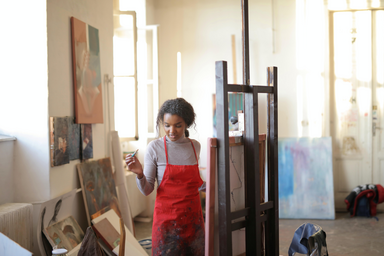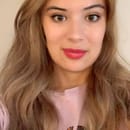A local artist based in Huntington, West Virginia, Sassa Wilkes, has been embarking on a colorful, role model filled journey to paint “100 badass women in 100 days.” During a year full of devastation and disappointment, Sassa decided to turn her attention to honoring exemplary women throughout the past and women making a difference in our society today. Her bright, joyful, and skilled oil portraits depict women from various parts of the world with backgrounds ranging from producer of the famous children’s show “Sesame Street” to our current Vice President-elect. One of the most interesting aspects of Sassa’s project is her personal growth throughout the creation of each of her paintings and her stories about how each woman that she painted impacted her, all of which are described in more detail on her website.
As someone who has a deep appreciation for art and occasionally dabbles in oil painting, to say I was excited to interview Sassa and learn more about this incredible project, would be an understatement. After browsing her website for hours and reading the stories under each of her portraits I found that many of her personal role models and women she finds to be most inspirational, are women that I also have always looked up to. For instance, the great artist Frida Kahlo or Jan Rader who is such an impactful and inspiring woman from our community, to name a few.
Tell us a little about your background and how it might have led you to become an artist.
SW: I’ve been making things for as long as I can remember. My mom is incredibly creative and thinks like an artist, and she was always making something. That’s just what we did in my house growing up. If we were bored, we made something. My grandmother was that way, too, and several other family members. Many of them did very traditional Appalachian crafts, quilts and things like that. I think my interest in drawing people came from some books my grandmother had about drawing the human figure. She used to draw pinups and send them to my grandfather overseas during WWII, and he traded them like currency.
How did you start making art? Why did you start making art?
SW: I don’t remember a time when I didn’t make art. I do remember the first time I was recognized for it in a way. It was some contest in kindergarten. I think it was a popsicle stick boat or something. I liked constructing three-dimensional things as a kid, out of cardboard or whatever. I was notorious for using an absurd amount of tape in my house. And I’ve always loved drawing.
Every structured art experience I’ve ever had, whether it was a class in school or craft time at bible school at my grandmother’s house, those were always the things I most looked forward to. Those were the times I felt alive and excited. Now I realize that art has always felt to me like a language, and I feel I speak it more fluently than any other language. I can communicate with art in a way I really can’t otherwise. Making art brings something out of me that has no other exit, and I may not always know what that something is, but I don’t really need to know. I just know that when I don’t make art, I’m not happy. I’m not whole.
What inspired you to start this project?
SW: The death of Ruth Bader Ginsberg inspired this project. Her death was the turd cherry on top of the crap sundae that has been 2020. I usually teach in a studio I have in town and hadn’t been able to because of COVID-19 . I was feeling so down. I spent the summer months making huge gardens and fences, building things in my backyard, and that helped. But I was starting to get worried about a lack of work, and I missed painting. And the world felt insane politically. After Ruth Bader Ginsberg died, I wanted to paint her and learn more about her life. So, I painted her and listened to documentaries and interviews, and it felt healing. I didn’t want to stop. I realized there were 100 days left in the year, so I committed to painting and learning about another woman every day. Sometimes a clear goal and a deadline is so helpful, I really needed it.
Who are some of your female role models?
SW: My mom and my grandmother have been my biggest female role models. Beyond that, I can’t really list any because I feel like all women are, in a way, role models to me, and I think we are all very connected. I don’t tend to rank people in my head or hold certain people as more special or important than others. I could see a woman being kind to her child in the store and that act could influence my thinking and behavior more than a celebrated woman I’ve read about. Everything I learn about the struggles and lives of women empowers me to be a more thoughtful, intentional, and empathetic person.
How do you go about choosing what women you are going to paint?
SW: I have a huge list of suggestions others have made for me, and I keep adding to it. I paint people who I want to know more about, and sometimes I even add people to the list who I think I may have the wrong impression of in some way. I want to learn about these women in my own authentic way. History really has a way of downplaying the accomplishments of women or tinting them with a weird cultural lens. I want to really know who they are/were and make up my own mind. I was a terrible history student, but it wouldn’t have mattered even if I was a great one. History books often either leave women out or show a biased view of them.
Which woman that you have painted so far have you felt most connected to or felt the most passionate about?
SW: I’ve felt such a connection to all of them in different ways, but one that stands out is Maya Angelou. I listened to her speak the whole time I painted her, and every word was like a vitamin that I was deficient in before I heard it.
What would you like the women on Marshall’s campus to take away from your project?
SW: I’d like to offer some advice to young women. Challenge yourself to really dig into the beliefs you hold about other women. Where do those beliefs come from? I’m ashamed to admit this, but before I painted AOC and Nancy Pelosi, I had a vague image of both of them in my head that they were a little too much. Too much what, I’m not sure. Too loud? Too harsh? Angry? I don’t know. But the point is, I didn’t put that belief there. We tend to believe the rhetoric we hear even when we don’t want to. Challenging your beliefs about other women will lead you to challenge and understand the beliefs you hold about yourself. Challenge the ideas you’ve bought into that have tainted the way you see yourself and other women. I’ve made it my life’s goal to shed as many of these false beliefs as I can. I want to know who I truly am, and I want to see others for who they truly are. It takes years to peel off all the layers of crap this world wraps us in. Try to think about what you were like as a kid, before they got to you. Start from there. Be patient and kind to yourself and each other.
Visit IamSassa.com to view her art and for more information on her projects and to read her experiences while painting each woman in more detail.



